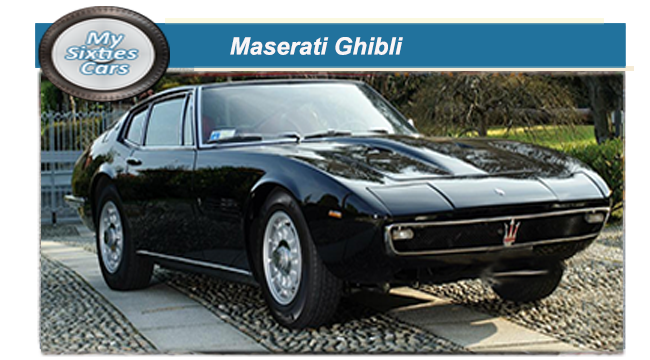
Of all the cars to bear the illustrious trident motif, the Ghibli is regarded as being the most charismatic and stylish.
The Ghibli was introduced at the 1966 Turin Motor Show, actually displayed on the Ghia stand. It stole the show, leaving the Ferrari Daytona and Lamborghini Miura well in its wake, both regarding sales and critical appreciation The gorgeo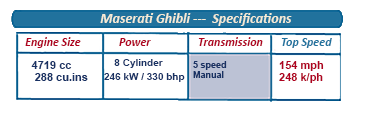 us looks and outstanding performance of the Ghibli have since earned it a well-justified place in the supercar hall of fame.
The Ghibli, like many of its Maserati stablemates, took its name from a strain of the wind, which turned out to be a fitting metaphor for the aerodynamically designed supercar, capable of breezing along at the highest of speeds.
With its design based mechanically on the previous Mexico model, Maserati used a shortened version of the tubular frame chassis and a more powerful 4719ec (288 cu in) quad-camshaft V8 engine for the Ghibli.
us looks and outstanding performance of the Ghibli have since earned it a well-justified place in the supercar hall of fame.
The Ghibli, like many of its Maserati stablemates, took its name from a strain of the wind, which turned out to be a fitting metaphor for the aerodynamically designed supercar, capable of breezing along at the highest of speeds.
With its design based mechanically on the previous Mexico model, Maserati used a shortened version of the tubular frame chassis and a more powerful 4719ec (288 cu in) quad-camshaft V8 engine for the Ghibli.
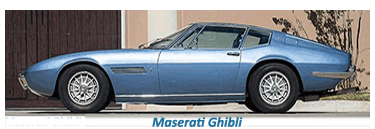 Maserati persisted with their concept with the Ghibli of mounting the engine was mounted at the front of the car, despite moves by a number of their competitors, in particular Lamborghini towards mid-mounted units.
The V8 engine was the most potent Maserati had built.
It was also all-alloy, with four camshafts and four Weber carburettors to feed fuel at the rate of around a gallon every 18km (11 miles).
Maserati persisted with their concept with the Ghibli of mounting the engine was mounted at the front of the car, despite moves by a number of their competitors, in particular Lamborghini towards mid-mounted units.
The V8 engine was the most potent Maserati had built.
It was also all-alloy, with four camshafts and four Weber carburettors to feed fuel at the rate of around a gallon every 18km (11 miles).
![]()
Options included manual and automatic transmissions, and a few convertibles were made, among the 1,274 examples built over the Ghibli’s seven-year production run.
The Ghibli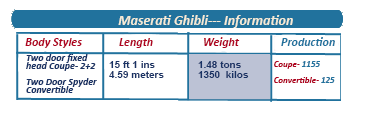 also used the Mexico's live rear axle and leaf springs, a fundamental configuration of a car that was capable of extreme levels of performance.
Although the car handled very well, at high speed the rear end could on occasion, prove difficult to control, especially for an inexperienced driver.
also used the Mexico's live rear axle and leaf springs, a fundamental configuration of a car that was capable of extreme levels of performance.
Although the car handled very well, at high speed the rear end could on occasion, prove difficult to control, especially for an inexperienced driver.
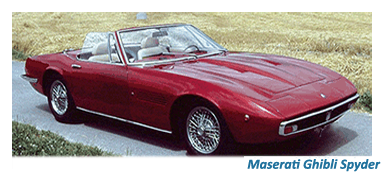 From a mechanical viewpoint, the Ghibli was little to get excited about. On the other, the Ghibli was fantastic to look at, with designer Giorgetto Giugiaro surpassing himself.
Giugiaro, at the time,holding down the role ashe chief designer for Ghia) was able to lower the profile of the bonnet, keeping the front end long, low and shark nosed.
Retractable headlights helped to keep the lithe looks during daylight hours, and the long and gently tapering rear end completed the distinctive Ghibli look.
From a mechanical viewpoint, the Ghibli was little to get excited about. On the other, the Ghibli was fantastic to look at, with designer Giorgetto Giugiaro surpassing himself.
Giugiaro, at the time,holding down the role ashe chief designer for Ghia) was able to lower the profile of the bonnet, keeping the front end long, low and shark nosed.
Retractable headlights helped to keep the lithe looks during daylight hours, and the long and gently tapering rear end completed the distinctive Ghibli look.
![]()
It was a real win/win situation as the Ghibli helped to establish Maserati among the world’s leading producers of luxury sports cars while Giugiaro's reputation as a top-flight designer was very much enhanced. , and the car was — and remains — acknowledged as the most beautiful Maserati ever.
Despite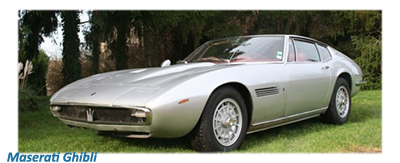 the critical success that the car enjoyed, Ghibli's production life was comparatively short.
Among the 1,274 examples built over a seven-year production run, notable owners included Sammy Davis Jr. and Peter Sellers.
More than half a century later, the Ghibli's star quality remains undimmed.
the critical success that the car enjoyed, Ghibli's production life was comparatively short.
Among the 1,274 examples built over a seven-year production run, notable owners included Sammy Davis Jr. and Peter Sellers.
More than half a century later, the Ghibli's star quality remains undimmed.






